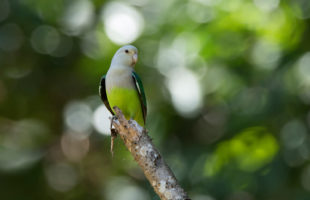Early in the morning, a deep, rather slowly repeated ‘bwup’ call can be heard in the rainforest. It is the call of the The pitta-like ground roller (Atelornis pittoides), a small bird that, like so many animals in Madagascar, is very special. Pitta-like ground rollers are endemic to Madagascar Pitta-like ground rollers are only found in Madagascar. They live in …
LesenSchlagwort-Archiv: Birds Madagascar
Red Fodys
Everything is a bit more colourful in Madagascar – even the sparrows on the roofs! The best example of this is the Madagascar Fody (Foudia madagascariensis). The Malagasy call him Red Fody, sometimes spelt Fodi or Foudi. Fodys are distributed all over the country. They are considered one of the most common birds in Madagascar. They can be found near …
LesenA partner for life: Grey-headed lovebirds
All over Africa, there are lovebirds: Small, colorful parrots that live with the same partner for life. They are not only famous for their lifelong pair bond, but also for extensive social behavior. Once a pair has found each other, the little birds are constantly seen cuddling or grooming each other’s feathers. Madagascar is also home to lovebirds, especially small …
LesenSuccessful hunter: Henst’s Goshawk
The Madagascar Goshawk or Henst’s Goshawk (Accipiter henstii) lives up to its name: it lives exclusively on the red island and cannot be found anywhere else in the world. It can often be seen circling high in the sky during the dry season. Henst’s Goshawk grows to 52 to 62 centimeters with an impressive wingspan of 86 to 100 centimeters. …
LesenThe Madagascan Nightjar
Swallows are actually known as diurnal. In the early morning, you can hear their shriiieeh calls, they spend the day in the air. However, the Madagascan Nightjar (Caprimulgus madagascariensis madagascariensis) is an exception. This unusual bird sleeps during the day, pressed close to the ground. The marbled plumage camouflages the animals perfectly, they disappear almost completely from the ground. Even …
LesenThe black Vasa Parrots
A curiosity of evolution: black parrots Madagascar has many fascinating animals. There is only one thing the island in the Indian Ocean does not have: large, colorful parrots. Instead, evolution has come up with something very special here. In the Malagasy tropics, parrots are completely black. The unusual birds are called Vasa Parrots. There are different species: One is the …
LesenTrickster with plumage: The Crested Drongo
Drongos populate the entire continent of Africa. Their habitat on the island of Madagascar is just as variable as the African continent. From dry forest to rainforest, from intact primary jungle to man-made farmland, the Drongo can cope with almost any environment. But the Drongo species on Madagascar is a special one: Here live the Madagascan, endemic subspecies of the …
LesenThe Crested Coua
Couas are only found in Madagascar. A particularly pretty representative of these colorful birds is the Crested Coua (Coua cristata). The back and tail feathers are purple, the breast feathers are rust-red, the head carries the eponymous mop of feathers. Around the eyes, as with all Couass, there is naked skin around the eyes, which glows blue in this species. …
LesenMadagascar’s bee-eaters
Bee-eaters (Merops superciliosus) are among the most colourful birds in Madagascar. Here and there it is called olive bee-eater. Including its tail this small bird measures up to 30 cm in length, and it is not even 50 g heavy. It is not easy to differentiate males and females by colour: Both wear a splendid green plumage with a beige-reddish …
LesenAnkarafantsika national park
Ankarafantsika: The word itself means “spiny mountains” and alludes to the famous gorge of the park. Ankarafanstika is also called “the Kingdom of Birds“. Location: Ankarafantsika National Park is located in northwestern Madagascar in the Ambato Boeny region. It is located 420 km north of Antananarivo and 115 km west of the port city of Mahajanga. The RN4 connects both …
Lesen MADAMAGAZINE Your Magazine about Madagascar
MADAMAGAZINE Your Magazine about Madagascar










